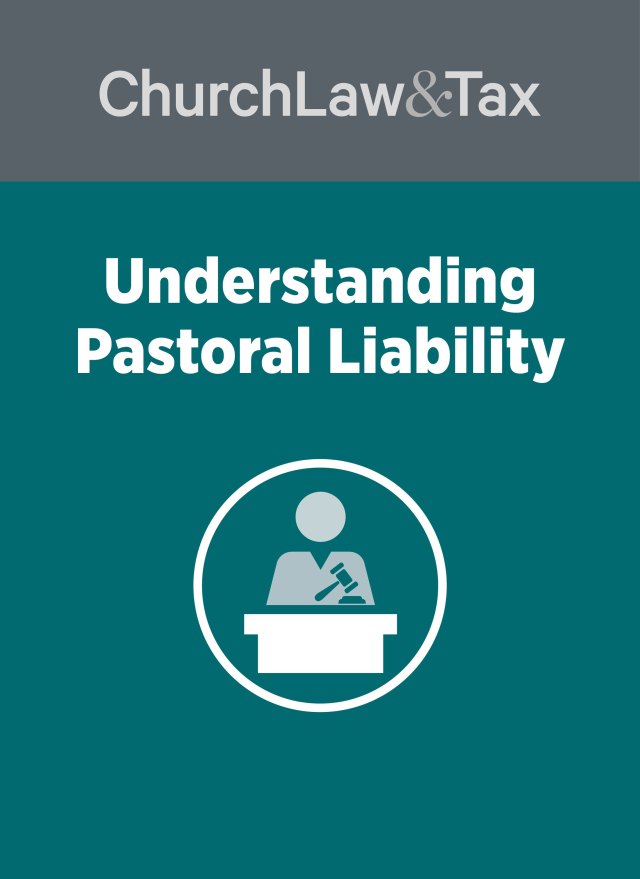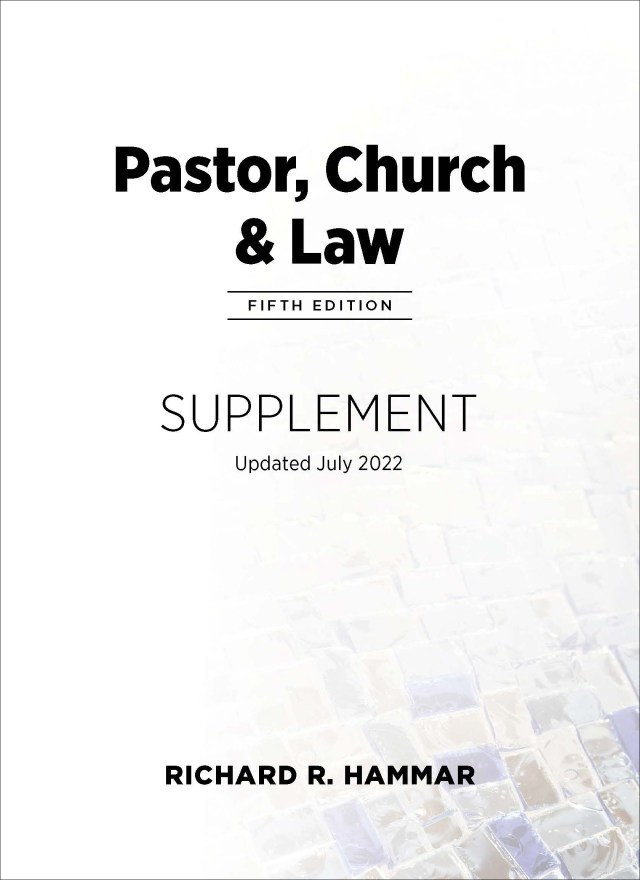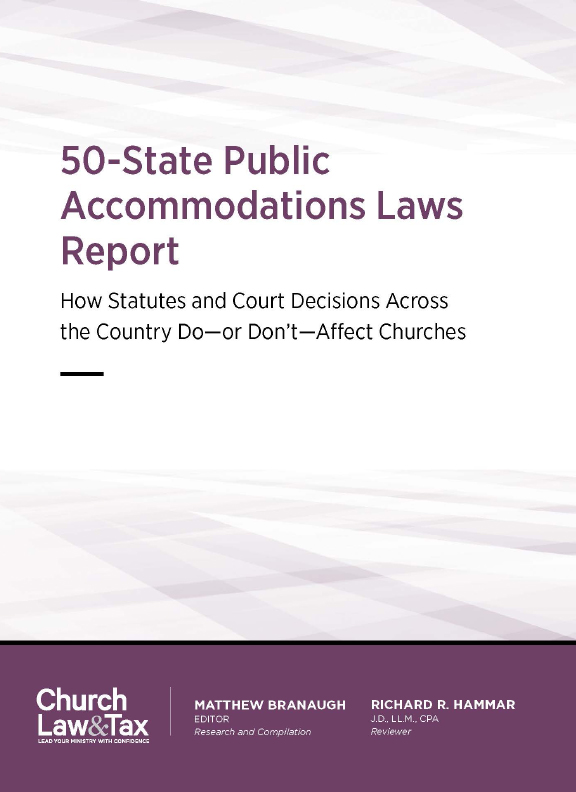• Key point: A church ordinarily will not be legally responsible for the sexual molestation of a child on church property or during a church activity unless it was negligent in hiring or supervising the molester.
• A New York appeals court ruled that a Catholic church and diocese could be sued as a result of the sexual molestation of an 11-year-old boy by a Catholic priest. The victim and his family were practicing Roman Catholics who attended and supported a local Catholic church. The victim and his sister were both enrolled in an parochial school operated by the church. An associate pastor at the church (who also served as director of religious education for the school) obtained permission from the victim's mother to take him to an athletic facility at a local college to play racquetball and basketball and go swimming. While in the shower room prior to entering the pool, the pastor allegedly removed all his clothing and made the victim do the same. He then kissed and fondled the victim against his will. The boy's mother later filed a lawsuit on behalf of her son naming the pastor, church, and diocese as defendants. She alleged that her son had suffered substantial emotional, mental, and physical injury, and that she had incurred substantial expenses in providing therapy for him. Specifically, she alleged that the pastor was guilty of clergy malpractice, intentional infliction of emotional distress, and breach of trust. She alleged that the church and diocese were liable on the basis of respondeat superior and negligent hiring and supervision. The court concluded that the clergy malpractice claim against the pastor and the respondeat superior claim against the church and diocese had to be dismissed, but that the breach of trust and intentional infliction of emotional distress claims against the pastor and the negligent hiring and supervision claims against the church and diocese should proceed to trial. The court observed that the clergy malpractice claim had to be dismissed "for the reason that the alleged wrongful conduct of the priest constituted intentional torts (assault and battery) which are independently pleaded as causes of action." The court quoted with approval from an earlier decision: "New York has adopted the prevailing modern view that once intentional offensive conduct has been established, the actor is liable for assault and not negligence, even when the physical injuries may have been inflicted inadvertently." However, the court concluded that the pastor could be sued on the basis of breach of trust and intentional infliction of emotional distress. The court acknowledged that other courts have refused to allow adult victims of clergy sexual misconduct to sue on these grounds, but it distinguished those cases with the following remarks:
[In the other cases] the alleged clergy misconduct occurred in the context of an established and existing ongoing pastoral counseling relationship—a setting in which the functioning of the clergyperson might naturally be expected to implicate dogma and practice of the religious body to which the cleric belonged, and in which the specter of excessive entanglement looms large. It is when what is sought is an evaluation of a member of the clergy while acting as a spiritual counselor that courts have refrained from undertaking to define a standard of care, for the reason stated [in a previous ruling]: "Any effort by this court to instruct the trial jury as to the duty of care which a clergyperson should exercise, would of necessity require the court or jury to define and express the standard of care to be followed by other reasonable … clergy of the community. This in turn would require the court and the jury to consider the fundamental perspective and approach to counseling inherent in the beliefs and practices of that denomination. This is as unconstitutional as it is impossible. It fosters excessive entanglement with religion."
The court emphasized that this case did not involve a counseling relationship between the pastor and victim, and accordingly there was no danger of implicating religious doctrine and practice in permitting the mother to sue the pastor on the basis of breach of trust and intentional infliction of emotional distress. The court further observed:
[A]lthough [the church and diocese] persistently assert first amendment protection, none makes any suggestion that the alleged sexual misconduct of [the pastor] is a part of the tenets or practices of the Roman Catholic Church, or that restraint on it by the imposition of civil liability will in any way intrude on the free exercise of religion to an extent protected by the first amendment. Indeed, inasmuch as it is conduct, and not creed, that underlies plaintiffs' actions, and that the potential for civil consequences exists equally as to religious and non-religious persons, and as to clergy and lay persons of all religions alike, the free exercise aspect of the first amendment does not come into play to preclude plaintiffs' actions.
Further, the court noted that even if the misconduct in this case had occurred in the context of a counseling relationship between the pastor and the 11-year-old boy, it would not have dismissed the breach of trust or intentional infliction of emotional distress claims as other courts may have done "for fear of venturing on a slippery slope into questions of liability impossible and unconstitutional to determine. This court does not share that apprehension, and is confident that the judicial process can provide a brake to the slide when needed."
Finally, the court addressed the liability of the church and diocese on the basis of both negligence and respondeat superior. With regard to the negligence claim, the mother asserted that the church and diocese were liable for the misconduct of the pastor on the basis of their own negligence in hiring and placing the pastor in contact with boys with inadequate investigation of his background and with actual or "constructive" knowledge of his propensities, and in failing periodically to evaluate his activities. The court rejected the argument of the church and diocese that permitting the civil courts to find religious organizations liable on the basis of negligent hiring or supervision of clergy would constitute excessive governmental interference with church autonomy in violation of the first amendment guaranty of religious freedom. The court observed:
[If the mother is] successful in establishing that, with knowledge that the priest was likely to commit sexual abuse on youths with whom he was put in contact, his employers placed or continued him in a setting in which such abuse occurred, the fact that the placement occurred in the course of internal administration of the religious units does not preclude holding the institutions accountable to the victim of their neglect in administration. Indeed, a contrary holding—that a religious body must be held free from any responsibility for wholly predictable and foreseeable injurious consequences of personnel decisions, although such decisions incorporate no theological or dogmatic tenets—would go beyond first amendment protection and cloak such bodies with an exclusive immunity greater than that required for the preservation of the principles constitutionally safeguarded. As the Supreme Court of Ohio has declared, "even the most liberal construction of the first amendment will not protect a religious organization's decision to hire someone who it knows is likely to commit a crime or tortious acts."
While the court was willing to allow the church and diocese to be sued on the basis of negligent hiring and supervision, it dismissed the mother's allegation of liability based on respondeat superior. Respondeat superior is a legal doctrine that imposes liability on an employer for the misconduct of an employee or agent committed within the course of employment. The court noted that "no New York case has been cited in which an employer has been held vicariously liable for intentional sexual misconduct by an employee," and that sexual misconduct by a priest "on its face scarcely seems to fall within the scope of employment of a priest" as would be necessary for the church and diocese to be liable.
This case is important for the following reasons:
First, it represents another case recognizing that clergy cannot be sued on the basis of malpractice for conduct that constitutes an intentional tort (such as assault and battery). In most states, victims must sue for assault and battery, not malpractice.
Second, the court permitted the victim to sue the priest on the basis of breach of trust and intentional infliction of emotional distress. The court concluded that judicial resolution of these claims would not involve impermissible interference with religious doctrine or practice.
Third, the court acknowledged that the civil courts ordinarily may not resolve lawsuits brought by adult victims of clergy sexual misconduct occurring in the course of a counseling relationship, since such lawsuits often will implicate religious doctrine and practice and the courts would be called upon to define a standard of care for such clergy. Such excessive involvement would violate the first amendment guaranty of religious freedom.
Fourth, the court emphasized that no constitutional limitations exist with respect to lawsuits brought by minor victims of clergy sexual assaults occurring outside of any established counseling relationship.
Fifth, the court concluded that the church and diocese could be liable for negligence in selecting and supervising the priest. This is one of the most important aspects of this decision, and underscores the importance of adopting adequate procedures in selecting clergy and in supervising them. Such procedures have been addressed in numerous articles in this newsletter.
Sixth, the court refused to find the church and diocese liable on the basis of respondeat superior. This is the conclusion that has been reached by most courts, since sexual misconduct certainly cannot be said to be in the course of the minister's duties. Jones by Jones v. Trane. 591 N.Y.S.2d 927 (Sup. 1992).
• The Alabama Supreme Court ruled that a local church was not legally responsible for the sexual molestation of a 10-year-old girl. A 10-year-old girl lived near a church that operated a kindergarten at which her aunt was the head teacher. The girl's mother instructed her to walk to the church following school, and then have her aunt escort her home when she quit work at 5:30 p.m. One day, while waiting on the church property for her aunt, the girl was raped by an adolescent male. The girl was raped a second time by the same adolescent several days later. The girl did not disclose the rapes to anyone until, during a routine medical examination, the family physician found evidence of sexual relations. The girl at first denied that she had ever engaged in sexual relations, but later acknowledged that the adolescent male (who was known to her) had raped her on two occasions. The girl's mother later filed a lawsuit against the rapist and the church. The mother claimed that the church had failed to use "due care" in watching and supervising the girl "thereby allowing" the rape to occur. A trial court ruled summarily in favor of the church, and the mother appealed. The state supreme court agreed that the church could not be legally responsible for the girl's injuries. The court acknowledged that there may have been an oral agreement between the mother and the aunt to care for the girl after school. However, the court insisted that "there was no evidence that [the victim] was, in fact, under the care of the church. The affidavit of the director of the kindergarten indicated that [the victim] was not enrolled in the kindergarten, and the mother's deposition indicated that also." The court continued:
[T]he mere fact that an injury has occurred is not evidence of negligence and … in negligent supervision cases negligence will not be found by inference. Assuming, without deciding, that there was an agreement that [the victim] was to be supervised and cared for by the church, [the victim] failed to produce any evidence demonstrating that the church negligently supervised her on the days she says she was assaulted and raped. Thus, a finding that [the girl] was negligently supervised on the days in question could be had only by inference [and] we may not draw that inference here.
The court also emphasized that churches ordinarily cannot be found guilty of negligent supervision without some special relationship or special circumstances that were not present in this case:
[The girl] argues that, while under the care and supervision of the church, she was brutally assaulted and raped by [the offender]. She and her mother attempt to rest the church's liability under the negligent supervision claim on the alleged criminal act of [the offender] …. [T]he general rule is that absent special relationships or circumstances, a person has no duty to protect another from criminal acts of a third person. We also recognize the difficulty of imposing liability on one person for an intentional criminal act of a third person. We held [in a 1990 ruling] that a defendant could not be held liable for the criminal act of a third party unless the defendant knew or had reason to know that the criminal act was about to occur on the defendant's premises. We reiterate our reluctance to impose liability on one person for the criminal act of another. The affidavits of the director of the kindergarten and the pastor of the church indicate that (1) they had no knowledge of other criminal acts of a similar nature that might have occurred on the church's premises; and (2) they had no knowledge of any previous criminal behavior by [the rapist]. Thus, the church made a prima facie showing that it was not responsible for the rape ….
This case is important because it places three distinct limitations on the liability of churches for "negligent supervision" that will be useful to other churches facing similar litigation:
First, the court emphasized that "negligent supervision" will not be found by inference. Negligent supervision refers to a failure to exercise due care in the supervision of workers or of children who are entrusted to the care of a church program or activity. This is a very important conclusion. Any victim of sexual assault on church premises can claim that the church was guilty of negligent supervision. However, such insinuations will not result in liability by inference.
Second, the court ruled that "absent special relationships or circumstances, a person has no duty to protect another from criminal acts of a third person." The court concluded that no such special relationship or circumstances existed in this case, presumably because the girl was not officially enrolled in any church or school activity in which she was engaged at the time of the alleged assaults.
Third, the court expressed great reluctance in imputing liability to a church or any other organization as a result of the criminal acts of a third party. The court concluded that an organization cannot be held liable for the criminal acts of a third party unless it "knew or had reason to know that the criminal act was about to occur on [its] premises." Since the church was aware of no similar incidents occurring on its premises, or of any previous sexual assaults committed by the alleged rapist, it could not be guilty of negligent supervision. N.J. v. Greater Emanuel Temple Holiness Church, 611 So.2d 1036 (Ala. 1992).
See Also: Negligent Supervision | Negligent Selection | Cases Finding Denominations Liable




